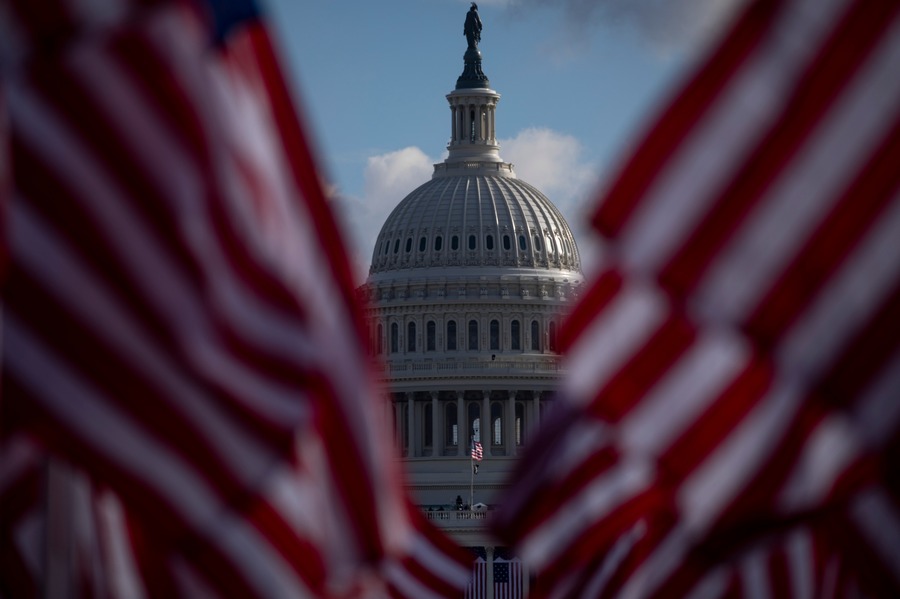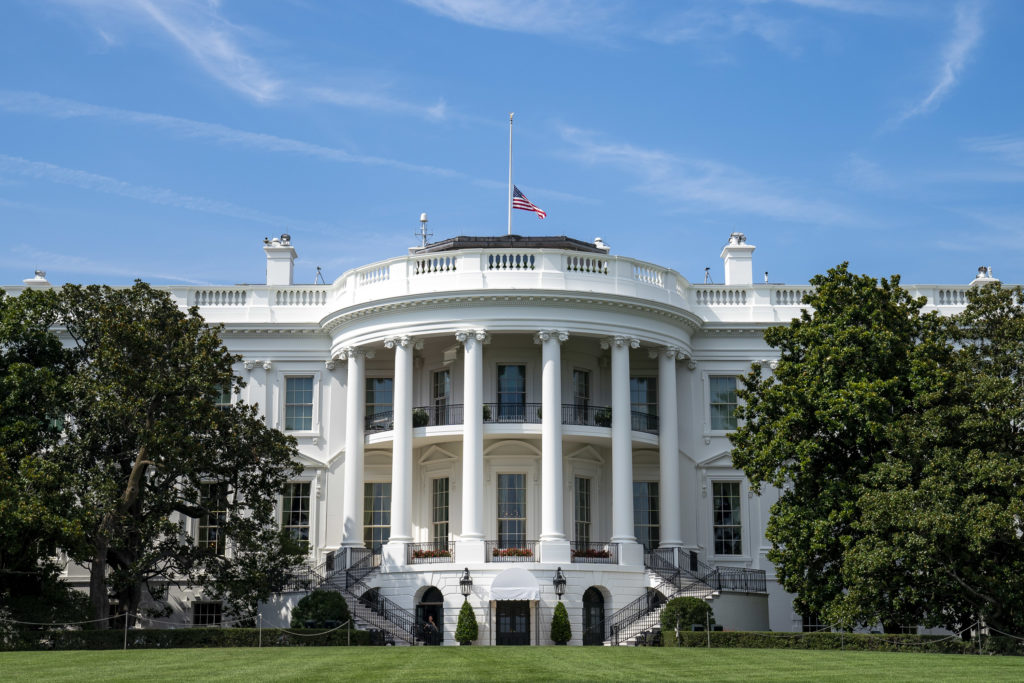Navigating Uncertainties in the Contingent Election Process

Published by The Lawfare Institute
in Cooperation With

With the 2024 presidential election upon us, the race has tightened by the day. Polls suggest it will likely come down to just a few states. There are even scenarios in which the race could result in a tie, with Kamala Harris and Donald Trump both receiving 269 electoral votes.
The U.S. Constitution requires a candidate to win a majority of the Electoral College votes to secure the presidency. While the majority threshold is typically 270 electoral votes, the Electoral Count Reform Act makes clear that in scenarios where not all 538 electoral votes are cast, a candidate must only secure a majority of electoral votes actually cast—not a majority of the total electoral votes.
What happens when neither candidate receives a majority? The answer is a “contingent election,” a procedure outlined in the Constitution’s 12th Amendment, which updated the original Electoral College provision in Article II. If no presidential ticket secures a majority of the Electoral College votes, Congress would decide the election. The House of Representatives would choose the president, while the Senate would choose the vice president. A contingent election has only occurred three times—in 1801 and 1825 for the president, and in 1837 for the vice president.
A contingent election would present many challenges for the country, especially in today’s political environment—marked by not only increased polarization but also political violence. Uncertainties in the process could worsen political division and further erode trust in the electoral system. It would also raise a number of practical considerations. The 12th Amendment establishes some potentially divisive rules for contingent elections. Most significantly, the amendment gives each state in a House contingent election a single vote, meaning the largest states would receive the same input as the smallest. By contrast, Washington, D.C., would have no representation in a contingent election. Additionally, the House and Senate could elect a president and vice president from opposing political parties—an outcome that might not be conducive to an effective working relationship at the top of the executive branch.
Addressing these issues would require a constitutional amendment. Still, there are a range of critical decisions lawmakers would have to make before conducting a contingent election in this year’s race.
This piece focuses on four of those potential decisions: (a) the voting thresholds required within each state delegation in a House contingent election; (b) the extent to which the proceedings should be confidential; (c) the lack of procedures for the death of candidates in a contingent election; and (d) uncertainties that could arise in a Senate contingent election of the vice president.
Voting Threshold Within State Delegations for House Contingent Elections
To elect the president, the 12th Amendment requires the House of Representatives to choose from a maximum of three candidates who received the most Electoral College votes. A majority of all states (26) is required to elect the president. A quorum consists of two-thirds of all states.
As noted, each state casts one vote as a whole. In states with more than one representative, each delegation must reach an agreement on how to award their state’s vote. However, the 12th Amendment is silent on how state delegations must reach this agreement. The voting threshold delegations use—presumably a majority or plurality requirement—is consequential when there is a third candidate in the running or when there are absences or vacancies in a delegation, which could make a majority threshold more difficult, or even impossible, to meet.
The House rules for the 1801 contingent election did not provide a required voting threshold within each delegation. Because there were only two candidates—Thomas Jefferson and Aaron Burr—any delegation that was not evenly divided cast its vote for the candidate with the higher number of votes within the delegation. In the 1825 contingent election, the House implemented a majority-vote requirement. If a delegation could not reach a majority, its ballot was considered “divided” and did not count in the wider House election. However, the majority threshold did not have an outsized impact on the outcome of the 1825 contingent election. Of 24 state delegations, 14 were unanimous in their choice, and the vast majority of the remaining 10 states had clear winners. The most divided state delegation was New York, with an 18-2-14 split among its representatives—just one vote over the majority threshold.
While the rules of a particular Congress are not binding on any future Congress, the 1825 contingent election established a precedent for implementing a majority-vote requirement within state delegations.
Majority and plurality voting thresholds each have their benefits and drawbacks, many of which are discussed in former Texas Congressman Martin Frost’s 1992 memorandum on the uncertainties facing contingent elections. In addition to the 1825 precedent, a majority-vote requirement would mirror the Electoral College’s requirement that a candidate receive a majority of electoral votes to win the presidency. The Constitutional Convention also utilized a majority-vote requirement within state delegations for its decision-making, and Congress’s current ballot voting provision requires a majority vote for internal House elections. Another benefit is that a majority-vote threshold avoids the possibility of a candidate winning a state’s vote with lower plurality support.
Alternatively, the House could adopt a plurality threshold to determine each state delegation’s vote. This approach would mirror the electoral systems of 48 out of 50 states, and Washington, D.C., which utilize a plurality requirement to determine the winner of their Electoral College votes. Additionally, a plurality vote would likely allow the House to reach a quicker result. A majority requirement could extend the election process, or even result in a deadlock, because the threshold would be harder to reach and would prevent delegations that failed to achieve majority results from casting their votes.
The risk of a prolonged process is worth attempting to avoid. The 1801 contingent election serves as an example of how these proceedings can be drawn out. Two states were initially unable to cast their votes due to ties in their delegations, which caused the election to take 36 ballots to elect the president. Ensuring a candidate is chosen by Inauguration Day is essential to prevent disruption in the new leadership of the executive branch. If no president is chosen by then, the 20th Amendment designates the vice president-elect to serve as acting president at the start of the new term. When there is no vice president-elect, the Presidential Succession Act of 1947 provides for the speaker of the House to act as president.
Importantly, a plurality requirement would also help maximize state representation. Millions, or even tens of millions, of Americans could go unrepresented in a contingent election if their state is unable to cast a vote. A plurality requirement would reduce the chances of there being “divided” state delegations barred from casting a vote (as was provided for in the 1825 House rules). The more likely that a result is reached within state delegations, the more states will have a say in electing the president.
Realistically, the majority party in the House would likely seek to implement a vote threshold that benefited them. For example, if the minority party held majorities or pluralities in enough state delegations to select the president, the majority party might attempt to implement a unanimity requirement in the delegations, which could result in the House contingent election deadlocking because many delegations would be unable to cast votes.
Confidentiality of Contingent Election Proceedings
The 12th Amendment is also silent on the confidential nature of House contingent election proceedings, largely because of the uncertainty surrounding the amendment’s “by ballot” language. The amendment requires the House of Representatives to “choose immediately, by ballot, the President.” The term “ballot” creates many uncertainties: Does it refer to public or secret ballots? What stage of the voting process does the “ballot” requirement refer to? Does it refer to the votes of the individual representatives within their state delegations, the votes of the states, or both?
There is no law or amendment that clarifies what the “by ballot” language requires. In 1825, the House interpreted the “by ballot” language to require voting in two stages. Members voted within their state delegations using secret paper ballots, and then public ballots were cast showing the states’ votes.
Public ballots would increase transparency. Other votes in the House of Representatives are public, so many Americans would likely want their representatives’ most important vote—to elect the president of the United States—to be public as well. Transparency enables the public to hold their elected officials accountable, and representatives would be insulated from accountability if their votes were secret. Additionally, secret ballots could lead to corruption or the perception of it. Accusations remain surrounding the rumored “corrupt bargain” of 1824, where Speaker of the House Henry Clay allegedly influenced Congress to elect John Quincy Adams over Andrew Jackson in exchange for Adams appointing him secretary of state. A secret vote could undermine confidence in the process.
Public ballots would also likely increase pressure on lawmakers. Representatives might follow their district’s vote for fear of being ousted from office. They might also hesitate to vote against their party’s candidate due to fear of being primaried, even if they believe that the opposing party’s candidate would be the best president. Furthermore, there have been a high number of threats against elected officials in recent years, and public votes may encourage these threats. Secret ballots could allow representatives to vote their conscience without being influenced by their political party or threats to their safety.
Some members could not cast secret ballots if the votes of each state were disclosed. There are currently six states with only one member in the House of Representatives. So, if state votes were made public in the ultimate House vote by the 50 states, as they were in all prior contingent elections, the individual votes of members who are the sole representatives of their states would effectively become public. Therefore, requiring both rounds of voting to be either public or secret would promote uniformity in the disclosure of all members’ votes.
Gaps in Law Addressing the Death of a Contingent Election Candidate
Another glaring issue would arise if a presidential or vice presidential candidate in a contingent election were to die. This scenario would arise if a candidate died in the time period between the Electoral College meeting in mid-December and before the conclusion of the contingent election proceedings, which would start in early January. It is possible, though not guaranteed, that a deceased candidate could be replaced before the Electoral College meeting. Congress currently has no procedures for selecting a replacement candidate in a contingent election.
Section 4 of the 20th Amendment grants Congress the power to establish laws outlining procedures for the “death of any of the persons” from whom the House or Senate may choose in contingent elections. However, in the 91 years since Section 4’s ratification, no law has been enacted pursuant to this enumerated power. There have been various attempts to address this issue, including legislation introduced by Sen. Paul Simon in the 1990s to designate replacement candidates and more recent efforts by Sen. Robert Portman in 2021 and Rep. Mike Johnson in 2023—before becoming speaker—to establish a panel of experts to recommend Section 4 policy considerations. Yet these proposals have been unsuccessful and largely ignored.
This leaves a serious vulnerability in our electoral system: If a contingent election candidate dies, tens of millions of voters could effectively be disenfranchised, as their party—and, consequently, their interests—would be eliminated from the presidential race.
In theory, Congress could enact a Section 4 law following a candidate’s death. Brian Kalt suggests in a comprehensive article that a statute enacting Section 4 should provide for a deceased presidential candidate’s vice presidential running mate to automatically become the replacement in the House contingent election. Kalt urged passage of such a law well in advance of when it might be needed, but the policy might still be implemented as a potential contingent election plays out. This approach honors the running mate’s role as an understudy, aligning with the presidential succession procedure outlined in the 25th Amendment. It facilitates a smoother transition of power by maintaining party continuity while also reducing the risk of gridlock or strategic behavior among House members that could arise if they were empowered to choose a replacement.
However, this scenario could lead to complications because the running mate would likely be a candidate in the concurrent vice presidential contingent election in the Senate. If the running mate transitioned from the vice presidential candidacy to assume the presidential candidacy, their party would be unrepresented in the Senate contingent election. This would not just eliminate the party’s chance of winning the vice presidency—it would also exclude the party from competing for the presidency if the House contingent election resulted in a deadlock.
In the event of the death of a vice presidential candidate in a contingent election, one potential solution would be to allow the presidential candidate to name a replacement. This approach would recognize the discretion presidential candidates have in choosing their running mates, as well as the president's authority, under the 25th Amendment, to nominate a replacement for a vice presidential vacancy. Additionally, the Senate would act as a check, similar to Congress’s role under the 25th Amendment, in approving vice presidential replacements.
As a practical matter, enacting a Section 4 law in the aftermath of a candidate’s death might face hurdles unless it was in the interest of the party that controlled both houses of Congress and the White House. If a deceased candidate’s party did not hold the White House and majorities in Congress, the opposite party could block a replacement from running in a contingent election, leaving the deceased candidate’s party and voters unrepresented.
The lack of procedures in this area is especially problematic in light of the prevalence of political violence in this country, evidenced by the recent assassination attempts on former President Trump. As Kalt noted in 2016, the absence of a candidate-replacement law might encourage assassination plots. Without a Section 4 law in place, the incentive to assassinate a candidate may be stronger during contingent elections than at any other time in the presidential selection process. The 12th Amendment limits the pool of electable candidates in contingent elections, meaning that the removal of one candidate also eliminates their entire party from the race. The stakes are particularly high in a contingent election scenario, as candidates are effectively locked in, with no established replacement procedures.
Uncertainties in Senate Contingent Elections
The Senate contingent election process is also rife with uncertainty. One question is whether the sitting vice president could cast a tie-breaking vote in a vice presidential contingent election—especially if the tie-breaking vote results in their own victory. Historically, vice presidents have exercised their tie-breaking power in various contexts—including votes for legislation, nominations, and procedural matters. While the Constitution appears to grant the vice president the power to cast tie-breaking votes without exception, the 12th Amendment says “the Senate shall choose the Vice President … and a majority of the whole number shall be necessary to a choice” (emphasis added). Whether the vice president is considered part of the “Senate” and “whole number” is unclear.
The Senate’s role in selecting a vice president becomes particularly crucial if the House cannot elect a president before Inauguration Day, because the vice president-elect would then be next in line to the presidency. However, internal Senate procedural rules like the filibuster could delay the voting process and impede the Senate’s ability to elect a vice president. To avoid this risk, a future Senate may consider amending its rules to preemptively ban the filibuster in contingent elections to help ensure a vote in this critical situation. Absent a rule change, a party with a slim Senate majority would likely lower the threshold to invoke cloture from 60 to 51—a process commonly referred to as the “nuclear option.” Without a change to the filibuster rules, the minority party in the Senate could block the chamber from selecting a vice president. This could result in the speaker of the House, who might belong to the party in the Senate minority, becoming acting president on Inauguration Day if the House had failed to pick a president.
***
Because Congress has not acted in advance to address the uncertainties facing the contingent election process, many rules would likely be based on the political self-interest of the majority party in the House and Senate. The way Congress chooses to address these unresolved issues is consequential not only for the outcome of the election but also for the public’s faith in the process.








